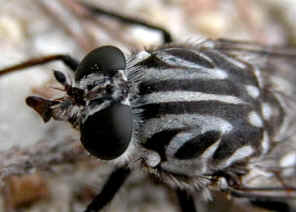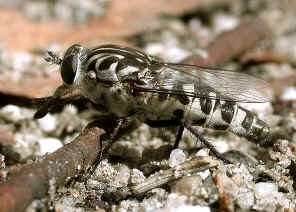Flower-loving Fly - Apiocera moerens
Family Apioceridae
This page contains pictures and information about Flower-loving Flies that we found in the Brisbane area, Queensland, Australia.

- Body length 20mm
- Apioceridae is a small fly family with only a single genus Apiocera. They are close related to Robber Fly Asilidae. Adults are essentially flower feeders but mostly found resting on ground. Their larvae are believed breed in soil and possibly carnivorous, somewhat similar to those in Asilidae.
- Flower-loving Fly


- Apiocera moerens, body length 20mm
- This fly is easily identified by its wing veins. Although they are called Flower-loving Flies and feed on flowers, they usually are found resting on ground.


- Pictures taken in Alexandra Hill, mid summer Jan 2004. We only saw this fly once.



- On Jan 2007, we saw this fly again in Karawatha Forest. Once again, it was very cooperated and let us took as many photos as we wanted. It was the same resting on the middle of the sandy footpath.
- On Jan 2010, we saw this Flower-loving Fly laying eggs on footpath in Carbrook Wetland. It was alone and it inserting its abdomen tip into soil in different locations. This female had the pointy abdomen, this imply the above two were male which they were waiting for female on the sandy path.


- This female did not allow us came too close to it, it always flied to a few meters away when we came closer. It flied just above ground and with very noisy sound which made us think it was a Sand Wasp when first noticed it.


- Reference:
- 1. Insects of Australia, CSIRO, Division of Entomology, Melbourne University Press, 2nd Edition 1991, p 758.
- 2. Insects of Australia and New Zealand - R. J. Tillyard, Angus & Robertson, Ltd, Sydney, 1926, p363 and plate 25 (Apiocera asilica).
- 3. Apioceridae - Tree of Life Project, 2004
Back to Top
[ Up ] [ BOMBYLIIDAE ] [ APIOCERIDAE ] [ MYDIDAE ] - 1. Insects of Australia, CSIRO, Division of Entomology, Melbourne University Press, 2nd Edition 1991, p 758.
